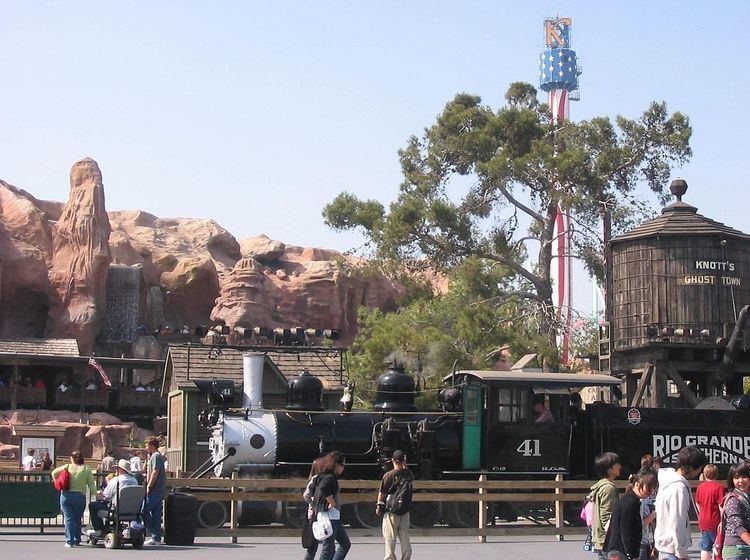Address Buena Park, CA 90620, USA Opened 12 January 1952 | ||
 | ||
Similar Knott's Scary Farm, Knott's Berry Farm, Corkscrew, Disneyland Railroad, Knott's Soak City | ||
The Ghost Town & Calico Railroad is a 3 ft (914 mm) narrow gauge heritage railroad within Knott's Berry Farm, a theme park in Buena Park, California.
Contents
Origin
Walter Knott began acquiring the authentic vintage equipment in 1951 and work began to grade and lay 3 ft (914 mm) narrow gauge track for a grand circle rail route for recently acquired rolling stock with service starting that November.
The railroad's opening ceremony commenced on January 12, 1952.
Unlike many other theme park railroads, the locomotives and most of the other equipment of the Ghost Town & Calico – Knott's Scenic Route have been restored to original paint schemes and appearance on Colorado's Rio Grande Southern Railroad and Denver and Rio Grande Western Railroad. Also unlike most theme park railroads used as transportation, it travels in a circle and riders disembark at the same place they alight – Calico Depot.
Locomotives
The roster includes two C-19 2-8-0 Consolidation type steam locomotives, both originally constructed for the Denver & Rio Grande in 1881. When retired from service in Colorado, they were D&RGW No. 340 Green River (formerly D&RG #400, renamed Gold Nugget No. 40 for many years on the GT&C) from the Denver & Rio Grande Western and RGS No. 41 Red Cliff (recently renamed Walter K at the 60th anniversary ceremony January 12, 2012) from the Rio Grande Southern. D&RGW No. 340 has now been rebuilt in 2015 and is being used, switching RGS No. 41 back and forth. Both locomotives are equipped with DRGW 5-chime whistles.
"Galloping Goose" motor rail buses kept the Rio Grande Southern railroad viable from the 1930s by carrying mail until they were used to scrap their own line in 1953. Knott also purchased this efficient and unique rail vehicle, the RGS Motor #3, which soldiers on at the GT&C on quieter days during the off-season – serving its original purpose when patronage does not justify hostling a steam engine to pull an entire train. It is "kitbashed" from its original Pierce-Arrow limousine frame, engine, radiator, cowling and body which was converted to rail use by replacing the front axle with a four-wheel bogie truck and fitting the rear axle with flanged wheels at first, then a bogie truck which linked the powered axle to its mate with a chain drive. A RGS shop-built freight box (converted with trolley seats for passenger service in 1950) articulates on the kingpin over the chain driven center truck. The wooden limousine sedan body was replaced after World War II with a 1939 Wayne military-surplus bus body with both left and right doors. Its Pierce-Arrow gasoline engine has been replaced, first with a war-surplus GMC gasoline engine at the RGS, then at Knott's with first a war-surplus in-line 6 cylinder Diamond-Reo gasoline engine, and since 1997 with a Cummins Diesel engine supported with an I-beam frame extension salvaged from the demolished Windjammer Surf Racers roller coaster.
In late 1973, the park received ex-D&RGW K-27 #464, a Mikado (2-8-2) locomotive. However, due to clearance issues, Knott's later donated the locomotive to the current owner and place of operation, the Huckleberry Railroad in Flint, Michigan.
Around the year 2010, Knotts Berry Farm had received Jennie K at H.K. Porter originally built as a(0-4-0) tank where it was going to be restored. Unfortunately, the locomotive had possibly been scrapped or delivered to another destination to be rebuilt. They had to do this because of the work on D&RGW No. 340.
Revenue
When the route opened on January 12, 1952 for passenger service, the locomotives would haul several yellow vintage closed-vestibule wooden passenger coaches led by a No. 103 parlor car Chama which was converted at Knott's in 1954 to combination baggage/coach Calico with arrows simulating an Indian attack embedded near the baggage door. Now the arrows are removed and the cars have been painted in heritage period Pullman-green livery of D&RGW. A gondola (converted from a flat car for open-air passenger seating), and a stock car (a.k.a. cattle car) which was converted from a gondola and now fitted with side benches and a wheelchair lift complete the consist filled with delighted guests on round trip excursions. They used to use a Rio Grande Southern Caboose but in 2012, it was taken out of service and replaced by a Pullman coach.
Display
The parlor car Durango restored in 2011, the Silverton observation sleeper and the No. B-20 Edna were held with the short two axle way car "bobber" caboose and a wooden box car D&RGW No. 3350, on sidings during normal operation. Nowadays the Silverton has been converted to revenue service as a chair coach, and the caboose serves to embark bandits while in motion.
The Business car B-20 Edna (formerly San Juan) was built for use by the Rio Grande Southern president Otto Mears on sidings and spurs as a portable office and temporary home while making track orders. She is fitted with
Track inspection as well as observation is facilitated by the open vestibule and enlarged end windows. These were deluxe temporary accommodations compared to a caboose, but it was far less opulent than private varnish of its day, which pales by comparison to the amenities offered aboard today's motor homes and recreational vehicles such as a shower or microwave oven.
Guest Experience
A journey on the Ghost Town & Calico – Knott's Scenic Route features a trip around Ghost Town and Boardwalk areas of Knott's, punctuated by a holdup by masked robbers, who have been known to announce their intentions by shouting, "This is a tax audit!" or similar tongue-in-cheek comments. Whether in the heavyweight steam train or the light duty Galloping Goose No. 3, the highlight most guests remember are the train robbers of the Knott's Scenic Route of the Ghost Town & Calico Railroad.
